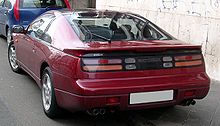Nissan 300ZX
| Nissan 300ZX | |
|---|---|
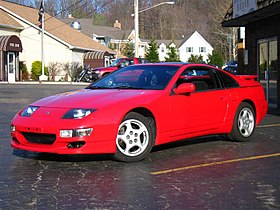 | |
| Overview | |
| Manufacturer | Nissan |
| Also called | Nissan Fairlady Z |
| Production | 1983–1989 (Z31) 1989–2000 (Z32) |
| Assembly | Japan: Hiratsuka, Kanagawa (Nissan Shatai) |
| Body and chassis | |
| Class | Grand Tourer / Sports car |
| Layout | FR layout |
| Chronology | |
| Predecessor | Nissan 280ZX |
| Successor | Nissan 350Z |
The Nissan 300ZX is a sports car in the Nissan Z-car family that was produced across two similar but unique generations. As with all other versions of the Z, the 300ZX was sold within the Japanese domestic market under the name Fairlady Z.[1]
Sold in Japan from 1983 to 2001 and in the United States from 1984 through 1996, the 300ZX name followed the numerical convention initiated with the original Z car, the Nissan S30, which was marketed in the U.S. as the 240Z. The addition of the "X" to the car's name was a carryover from its predecessor, the 280ZX, and signified the presence, either standard or optional, of rear seats.
Despite the presence of that additional equipment, the first generation "Z31" variant of the 300ZX (1983-1989) continued in the tradition of the original S30 as a mid-priced model. The second generation "Z32" was driven up-market, being faster, more capable, more advanced, and much higher priced than its predecessor, with consecutive price increases each model year of availability. As such, the Z31 was the more accessible, and ultimately the more popular model, selling over 100,000 more units in total than the Z32. In 1983-1984 the Nissan 300ZX Turbo brand new priced around $12,000-$18,000
Car and Driver placed the Z32 on its Ten Best list for 7 consecutive years, each model year of its availability in the United States. Motor Trend awarded it as the 1990 Import Car of the Year.[2] The Nissan 350Z, officially the Z33 generation Z-Car, succeeded the 300ZX in 2003.
Contents
Z31[edit]
| Z31 | |
|---|---|
.jpg) | |
| Overview | |
| Production |
|
| Designer | Kazumasu Takagi[4] (1982) |
| Body and chassis | |
| Body style | |
| Powertrain | |
| Engine | |
| Transmission | |
| Dimensions | |
| Wheelbase |
|
| Length |
|
| Width | 1,725 mm (67.9 in) |
| Height | 1,260 mm (49.6 in) |
| Curb weight | 2,888–3,280 lb (1,310–1,488 kg) |
| Chronology | |
| Predecessor | Nissan 280ZX |
| Successor | Nissan 300ZX (Z32) |
The Z31 chassis designation was first introduced in 1983 as a 1984 Nissan/Datsun 300ZX (the hatch lid had both a Datsun and a Nissan badge) in the U.S. market. The 300ZX, as its predecessors, was known as a Nissan in other parts of the world. This continued in the U.S. until the 1985 model year when Nissan standardized their brand name worldwide and dropped the Datsun badge. All publications for the Z31 chassis 300ZX and its predecessors were copyright Nissan North America. Designed by Kazumasu Takagi and his team of developers, the 300ZX improved aerodynamics and increased power when compared to its predecessor, the 280ZX. The newer Z-car had a drag coefficient of 0.30 and was powered by Japan's first mass-produced V6 engine instead of the inline 6 of the previous Z-cars. According to Nissan, the new V6 engine was intended to uphold the sporty, six-cylinder spirit of the original Fairlady Z, but in a more compact and efficient package.[4]
The Z31 generation featured five engine options. A turbocharged dual over head cam 2.0 L straight-six (RB20DET, used in the 200ZR), a turbocharged single over head cam 2.0 L V6 (VG20ET, found in 200Z/ZS/ZG), a naturally aspirated single over head cam 3.0 L V6 (VG30E, found in 300ZX), a turbocharged single over head cam 3.0 L V6 (VG30ET, used in 300ZX Turbo) and a naturally aspirated dual over head cam 3.0 L V6 (VG30DE, used in 300ZR). The Z31 had electronic fuel injection (EFI), and was rear wheel drive. The Z31 was available in either left or right hand drive.
Two Special Edition versions of the Z31 generation model were produced; a 50th Anniversary Edition celebrated the company's semi-centennial in 1984 and offered additional luxury features, and a "Shiro Special", released four years later, with performance-oriented upgrades.[5][6][7] Unlike its predecessors, the Z31 featured a V6 engine in the 200Z/ZS/ZG, 300ZX and 300ZR, and the only Z31 to come with an Inline 6 cylinder engine was the Fairlady 200ZR which was only available in Japan. The new V6 (2960 cc) Single overhead cam engine was available as a naturally aspirated VG30E or a turbocharged VG30ET producing 160 hp (119 kW) and 200 hp (150 kW) respectively. The engine was either a type A or type B sub-designation from 1984 to March 1987, while models from April 1987 to 1989 had a W sub-designation. The W-series engines featured redesigned water jackets for additional cooling, and fully floating piston wrist pins. The 1984 to 1987 turbo models featured a Garrett T3 turbocharger with a 7.8:1 compression ratio, whereas 1988 to 1989 models featured a low inertia T25 turbocharger with an increased 8.3:1 compression ratio and slightly more power—165 hp naturally aspirated and 205 hp (153 kW) turbocharged. Finally, these engines were equipped with self-adjusting hydraulic valve lifters. The transmissions were a 5-speed manual or an optional 4-speed automatic (all Z31 automatics were the E4N71B equipped with torque-converter lockup including turbo models). All Z31s were equipped with a Nissan R200 rear differential, April 1987 and later turbo models received an R200 clutch limited-slip differential except 1988 Shiro Specials which had a Viscous-type limited slip. There were three trim models available: SF, GL and GLL. The SF model was only available in Canada.
Select 300ZX models (as well as some other Nissan models of the time period) could also be equipped with a digital gauge cluster that also utilized a "Voice Warning System". The Voice Warning System used the vehicle's radio and driver's door speaker to mute the radio and provide a vocal warning whenever a door was ajar, the exterior lights were left on after the vehicle was turned off, the key was left in the vehicle's ignition when the driver's door was opened, or the fuel level was low. The system operated using a small box that integrated a small phonograph with a "needle" that dropped onto a plastic "record" and played the appropriate message, unlike the similar Electronic Voice Alert (EVA) system in select K-Platform vehicles from Chrysler, Dodge, and Plymouth that used an electronic chipset developed by Texas Instruments (TI). Since the Voice Warning System utilized the 300ZX's factory radio to play the vocal warnings, the system would no longer function if an aftermarket head unit was installed into the vehicle.
Other technological features in the 300ZX included a "Body Sonic" audio system that utilized a separate amplifier and speakers in the vehicle's front seats that allowed bass from music to be felt by the vehicle's occupants, and a fully digital climate control system.
Japanese market[edit]
The 200Z, 200ZG, and 200ZS used the VG20ET engine while the 200ZR came with the RB20DET. The 300ZX came with the VG30ET, with the same spec as the USDM model. The only factory Z31 variant to use the VG30DE engine was the 300ZR.[8] It continued to be marketed as a companion fastback to the more formal appearance of the Nissan Skyline-based Nissan Leopard coupe at Nissan Bluebird Store Japanese dealerships. Starting with this generation, the Fairlady ZX, as it was known in Japan, no longer complied with Japanese Government dimension regulations, which Japanese buyers were now liable for additional yearly taxes that affected sales. Japanese consumers who wanted a sports car that was in compliance had the Gazelle that shared much of the technology with the larger ZX, but at lower cost.
European models[edit]
The European models made 240 hp (180 kW)[9] in turbo form due to a better camshaft profile, also known outside of Europe as the Nismo camshafts. Some models were also equipped without catalytic converters. All European turbocharged models received a different front lower spoiler as well, with 84-86 models being unique and 87-89 production having the same spoiler as the USDM 1988 "SS" model.
Australian models[edit]
All Australian model Z31 300ZXs were 2+2 T-top body. The cars sold in 1984 and '85 were all naturally aspirated with no catalytic converter, while the turbocharged version was the only model available from 1986 to 1988. There was only one trim level in Australia, with the digital dashboard and climate control being an optional upgrade package, and leather seats only available in the redesigned series 3 "Californian" models. The Australian factory service manual provides camshaft measurements which do not match any of the known USDM or EDM camshaft profiles, the FSM states the exhaust valve has an open duration of 252 degrees, but the specified opening and closing angles add up to 258 degrees. All Australian publication content express that N/A versions possess 166 hp (124 kW), along with the turbocharged versions as 208 hp (155 kW).[10] The Australian 50th Anniversary Edition was more basic than the U.S. version, the 50th AE was a normal n/a 300ZX with the digital dash package, a black interior, black velour seats, and a 50th AE badge on the exterior. The exterior badge was fixed to the cars by dealerships, so the position of the badge is not the same on all models. There was no Shiro Special in Australia, and no models featured the adjustable shock absorbers.
Chassis[edit]
The Z31 chassis was based on the 280ZX. Although the newer chassis had the same wheelbase and MacPherson strut/semi-trailing arm independent suspension, it handled and accelerated better than the 280ZX it replaced. Turbocharged models, except for the Shiro Special edition, had 3-way electronically adjustable shock absorbers.
Special Z31 releases[edit]
Nissan manufactured two special Z31 models. The 1984 300ZX 50th Anniversary Edition, released to celebrate the automaker's half-century, was a turbocharged coupe (two-seater) model with a Silver/Black color scheme. All 50th Anniversary Edition came equipped with a digital dash and ancillary gauges including average mileage, G-force, and compass readouts, in-car electronic adjustable shocks, Bodysonic speakers in the seats, cruise and radio controls in the steering wheel, mirrored t-tops, embroidered leather seats, embroidered floor mats, sixteen-inch (406 mm) aluminum wheels, rear fender flares, flared front fenders, a 50th AE logo badge on the driver's side front fender, and grey cloth indoor car cover with 50AE printing. The only option available to the 50th Anniversary Edition was the choice between an automatic or a 5-speed manual transmission. 5,148 AE models were produced for the U.S. market and 300 for the Canadian market. A non-turbo 2+2 model was available with 50AE badging in the Australian market.
In 1988, the turbocharged Shiro Special debuted with pearl white paint, stiffer springs and matched shocks, heavy-duty anti-sway bars, a unique front air dam, paint matched wheels, Recaro seats with matching door panels, painted bumperettes, white painted door handles and a viscous limited-slip differential. No options were available for the Shiro. It was the fastest car out of Japan, capable of 153 mph (246 km/h) speeds, as tested by Motor Trend with the electronic speed limiter disabled.[5] A total of 1,002 Shiro Special Z31s were produced for the U.S. market between January and March 1988.[6]
Style and evolution[edit]
The Z31 body was slightly restyled in 1986 with the addition of side skirts, flared fenders, and sixteen inch wheels (turbo models only). Many black plastic trim pieces were also painted to match the body color, and the hood scoop was removed. The car was given a final makeover in 1987 that included more aerodynamic bumpers, fog lamps within the front air dam, and 9004 bulb-based headlamps that replaced the outdated sealed beam headlights. The 300ZX-titled reflector in the rear was updated to a narrow set of tail lights running the entire width of the car and an LED third brake light on top of the rear hatch. The Z31 continued selling until 1989, more than any other Z-Car at the time. Over 70,000 units were sold in 1985. Cars produced from 1984 to 1985 are referred to as "Zenki" models, while cars produced from 1987 to 1989 are known as "Kouki" models. The 1986 models are a special due to sharing some major features from both. They are sometimes referred to as "Chuki" models, but are usually grouped with the Zenki models because of the head and tail lights.[7]
Z32[edit]
| Z32 | |
|---|---|
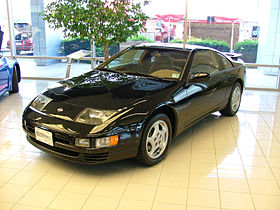 | |
| Overview | |
| Also called | Nissan Fairlady Z |
| Production |
|
| Designer | Isao Sono & Toshio Yamashita (1987)[citation needed] |
| Body and chassis | |
| Body style |
|
| Powertrain | |
| Engine | Twin Turbo |
| Transmission | |
| Dimensions | |
| Wheelbase | 2,450 mm (96.5 in) 2+0[1] 2,570 mm (101.2 in) 2+2[1] |
| Length | 4,305 mm (169.5 in) 2+0[1] 4,520 mm (178.0 in) 2+2[1] |
| Width | 1,790 mm (70.5 in) 2+0[1] 1,800 mm (70.9 in) 2+2[1] |
| Height |
|
| Curb weight | |
| Chronology | |
| Predecessor | Nissan 300ZX (Z31) |
| Successor | Nissan 350Z |
The Z32 was a new design. The body was wider with a rounder profile and fewer hard edges. It had a marginally increased drag coefficient of .31 compared to the Z31's .30. Twin Turbocharged Z32s also featured active rear wheel steering systems called "Super HICAS", first introduced on the HR31 Nissan Skyline, which was actuated hydraulically until 1994 when Nissan switched to an electric actuator. Nissan designated the final 300 units earmarked for North American sale in 1996 as "Commemorative Edition" cars, although nothing new or exclusive to the model was included. The 1996 model years vehicles did not feature Nissan's NVTC variable valve timing system, which had been present on all previous Z32 models. Production continued in Japan until August 2000, with styling updates and the addition of HID headlamps in 1998.[4]
Unchanged from the previous generation 300ZX was the displacement of the 2,960 cc (3.0 L) V6 engine, now with DOHC and variable valve timing (N-VCT), rated at 222 hp (166 kW) and 198 lb⋅ft (268 N⋅m) in naturally aspirated (NA) form. The twin turbo (TT) variant was upgraded with Garrett AiResearch twin-turbochargers and dual intercoolers producing 300 bhp (304 PS; 224 kW) at 6,400 rpm and 283 lb⋅ft (384 N⋅m) of torque at 3,600 rpm.[11] Performance varied from 0-60 mph (97 km/h) times of 5.0-6.0 seconds depending on the source, and it had a governed top speed of 155 mph (249 km/h).
The Z32 300ZX was the first car to be marketed following the introduction of the 280 PS (206 kW) power ceiling imposed by JAMA that remained until 2004.[12]
American Z-car sales reached one million sales during the 1990 model year, making it at that time the best selling sports car.[13]
Nissan utilized the Cray-2 supercomputer to design the new 300ZX with a form of CAD software[14] making it one of the first production cars to utilize this tool. On the twin turbo models, four-wheel steering was available under the name Super HICAS (High Capacity Actively Controlled Steering).
Like previous generations Nissan offered a 2+2 model with the Z32. In 1992, a convertible version (produced by ASC[15]) was introduced for the first time, as a response to aftermarket conversions. Most 300ZXs now featured T-tops as standard. A few steel top models were available.
The Japanese Domestic Market was offered a number of trim variants not available in international market. This included the "Version R" with Recaro front seats, leather rear seats and larger side skirts.
In America the 300ZX faced the same fate of many Japanese sports cars of the time. The mid-1990s marketplace trends toward SUVs and the rising Yen:Dollar ratio contributed to the end of North American 300ZX sales in 1996 with over 80,000 in sales. However, production for other markets continued until 2000. While the 1989 300ZX was priced at around $30,000, its final model year price increased to about $50,000. A Commemorative Edition for the final 300 units shipped to America included decals and certificates of authenticity. In Japan, the 300ZX continued until 2000, with a facelift in 1998 that featured a new fascia, tail lights, head lights, rear spoiler, and other minor changes.
In 1990, Motorsports International of Waco, Texas collaborated with Japanese tuning company HKS to create the SR-71 300ZX. The cars were upgraded with larger Garrett turbochargers, HKS electronics and a Kaminari body kit designed for the SR-71 by Pete Brock. The SR-71 was California CARB certified and was to be sold through a select dealer network and Japanese performance tuning shops located within the United States. Officially, a total of eight cars were produced and were numbered #000-#007. But there were others custom-made. The exact number is not known. The SR-71 claimed the title of the third fastest production car in the world in 1990 for a fraction of the price of a Lamborghini Diablo and Ferrari F40 according to the designer Randy Ball.[citation needed] The base price was $65,000 for the 300ZX and SR-71 conversion.[16]
In 1995 and 1996, Steve Millen Motorsports (Stillen), developed a SMZ model with Nissan North America that were sold throughout the U.S. and Canada through designated Nissan dealerships. The performance upgrades were covered by the factory warranty. Each vehicle was numbered in the engine bay and interior. A total of 104 SMZs were produced at $14,000 more than the standard Nissan 300ZX Twin Turbo.
Style and evolution[edit]
The Z32 chassis underwent some changes during its production run between 1989 and 2000 (Japan) and 1990 to 1996 (US). Among the safety additions are the inclusion of standard driver and passenger-side airbags and true pillar-mount seat belts. The Z32's extended model year sales in 1990 reached 39,290 units.[17]
1991
- Manual climate controls discontinued (except convertible models)
- New electronic climate controls allowed control over air flow direction, but the ambient temperature gauge was discontinued
- Air conditioner evaporator valve changed from aluminum to steel to reduce noise
- Driver's airbag available as an option
- CD player option was added for both the TT and NA (previously only available in the NA), while the Bose stereo head unit changed
- Front brake rotors on NA models were changed to TT units (previous front rotors were 4 mm thinner)
- Brake master cylinder was changed to a new unit (February 1991)
- Nissan logo appears on front fascia
- Hardtop coupe available mid-year (NA only)
- Floor mat logo changed from "300ZX" to "Z"
- Keyhole on driver's door and interior light illuminates when door handle is pulled (similar to Z31)
- Sales: 17,652 units[17]
1992
- Driver's airbag made standard
- Dashboard and door complementary material changed from fabric to suede
- Separate mirror heater switch eliminated (combined with rear defroster switch)
- Power adjustable driver's seat standard on t-top models
- Mirror heaters made standard
- Sales: 6,708 units[17]
1993
- Turbo oil line insulation changed
- Convertible option added
- Brake caliper material changed from aluminum to iron
- New style fuel injectors for the non-turbo, (except convertible)
- Upgraded Bose stereo made standard
- Air injection valve (AIV) system eliminated
- Non-turbo model, (except convertible), ECUs changed from 8-bit to 16-bit by Japan Electronic Control System Co.
- Sales: 11,599 units[17]
1994
- Rear spoiler design changed to a taller, pedestal-type
- Seat belts redesigned; attachment moved from door mounts to pillar mounts
- Super HICAS system changed to an electrically actuated unit (previously power steering actuated)
- New style fuel injectors for the convertible
- Passenger's side airbag introduced and made standard
- Keyless entry added
- Titanium keys discontinued in November 1994
- 'Reset' button removed from clock
- Off-white 'Pearl' color is dropped. Future 'Pearls' are more of a semi-metallic white
- Sales: 5,320 units[17]
1995
- New style fuel injectors for the twin-turbo
- Front fascia became body coloured instead of gray strip
- Twin-turbo model ECUs changed from 8-bit to 16-bit (in late-1994 model year)
- Special 25th Anniversary gold paint available
- Sales: 3,135 units[17]
1996
- Variable cam timing (NVTC) dropped due to emission regulations
- OBD II electronics introduced
- Driver's seat back rest no longer included adjustable side bolsters[17]
- Sales: 2929 Units total, The last 300 of which are the "Commemorative Edition"[18]
Advertising[edit]
Nissan aired a commercial during Super Bowl XXIV in 1990 advertising the new Nissan 300ZX Twin Turbo. The 60-second commercial was directed by Ridley Scott and only aired once. Executives at Nissan pulled the commercial after the initial airing when they became concerned the commercial would promote street racing since the commercial features the 300ZX being faster than a sport bike, a formula one car and a fighter jet.[19][20]
Motorsports[edit]
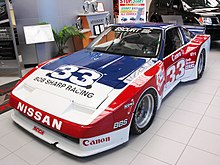
The 300ZX was campaigned during 1984 and 1985 in showroom stock racing. The car scored a Trans Am win in 1986 at Lime Rock by Paul Newman for Bob Sharp Racing.[21] This would be the only Trans Am win by a 300ZX.[citation needed]
From 1985 to 1987, the Electramotive-developed GTP ZX-Turbo was raced in the IMSA GT Championship's GTP class and also the All Japan Sports Prototype Championship, badged as a Fairlady Z, using a Lola T810 chassis and a VG30ET engine. Following development through 1987, the car would become dominant in IMSA GT in 1988. Additional factory endorsement, combined with a new chassis, transmission and more reliable Goodyear tires contributed to the team's success. The SOHC VG30ET was making upwards of 1,000 hp (700 kW), with a power band that extended from 4,000 to 9,000 rpm on a single turbo.[22]
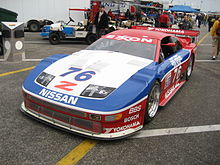
From 1990 to 1995, Steve Millen drove the twin turbo 300ZX for Clayton Cunningham Racing. The car dominated the IMSA in its GTO, then later GTS categories due to its newly designed chassis and engine. Millen would rank as the #1 Factory Driver for Nissan for 7 years and earn two IMSA GTS Driving Championships and two IMSA GTS Manufacturer's Championships. The biggest triumph for the Z32 racecar was the victory in the 1994 24 Hours of Daytona. In the 1994 24 Hours of Le Mans, the 300ZX ranked first in the GTS-1 class and 5th overall. In an attempt to level the playing field in the GTS-1 class by reducing the allowable horsepower, the IMSA declared the twin turbo VG engine ineligible for the 1995 season.[23] The 1995 GTS 300ZX car would debut with the V8 Nissan VH engine at Daytona[24] and would place first in the GTS-1 class at the 12 Hours of Sebring and Mosehead Grand Prix in Halifax.[25]
The JUN-BLITZ Bonneville Z32 holds the E/BMS class land speed record of 260.87 mph (419.84 km/h) set at the 1995 Bonneville Speed Trial.[citation needed] The vehicle was built as a partnership between JUN Auto and BLITZ. In 1990, JUN's first Z32 went 210.78 mph (339.2 kph) at their Yatabe test course and hit 231.78 mph (373 km/h) after some tuning at Bonneville.[26]
Awards and recognition[edit]
- 1990: The 1990 300ZX Turbo is named Motor Trend's "Import Car of the Year". Motor Trend also names it, "One of the Top Ten Performance Cars". Automobile magazine named the 300ZX Turbo to its "All Stars" list. Road & Track picked the 300ZX Turbo as "One of the Ten Best Cars in the World". Car and Driver included the 300ZX Turbo in their list "One of the 10 Best Cars"
- 1991: The 300ZX Turbo is listed in Car and Driver's 10Best, and is again one of Automobile magazine's "All-Stars"
- 1992: Car and Driver includes the 300ZX Turbo in its "10 Best", and Automobile magazine names it to its "All-Stars" list
- 1993: The 300ZX Turbo is included in Car and Driver's 10Best, and one of Automobile magazine's "All-Stars".
- 1994: The 300ZX Turbo is listed on the Car and Driver's 10Best and on the "All Stars" list by Automobile magazine
- 1995: The 300ZX Turbo is included in the "10 Best" list by Car and Driver
- 1996: For the seventh straight year the 300ZX Turbo is on Car and Driver's 10Best list, this is also the final year of U.S. sales
- 2004: Automobile lists the Z32 as one of the 100 greatest cars of all time
- 2006: Automobile lists the Z32 on both the "20 Greatest Cars of the Past 20 years" and the "25 Most Beautiful Cars in History"
- 2010: GQ Magazine lists the Z32 as one of the most stylish cars over the past 50 years[27]
From the year it was introduced, the Z32 has also won many comparison tests against similar sports cars such as the Mitsubishi 3000GT/Dodge Stealth, Mazda RX-7, Chevrolet Corvette, Toyota Supra, Dodge Viper, and the Porsche 968.[28]
Safety[edit]
In Australia, the 1990 to 1995 Nissan 300ZX was assessed in the Used Car Safety Ratings brochure as providing "average" protection for its occupants in the event of a crash.[29]
In the US, the National Highway Traffic Safety Administration (NHTSA) gave the 1991-1993 300ZX 3 out of 5 stars in front driver collision crash test ratings.[30]
Notes[edit]
- ^ Jump up to: a b c d e f g Nissan 300ZX 1991 Service Manual No. SM1E-0Z32U0. Tokyo, Japan: Nissan Overseas Service Department. December 1990.
- ^ "Motor Trend Import Cars of the Year Complete Winners List". Motortrend.com. Retrieved 2012-01-22.
- ^ Jump up to: a b Long, Brian (2004). Nissan 300 ZX/350 Z. Veloce Publishing. p. 203. ISBN 978-1-904788-04-1.
- ^ Jump up to: a b c Long, Brian (1999). Datsun/Nissan 280/300 ZX. Veloce Publishing. pp. 66–69. ISBN 978-1-901295-06-1.
- ^ Jump up to: a b Z-Club Hungary. "Nissan 300ZX - Z31". Archived from the original on 2007-09-30. Retrieved 2007-02-20.
- ^ Jump up to: a b ZBUM. "US 1988 300ZX SS Registry and Information". Retrieved 2007-02-20.
- ^ Jump up to: a b ZBUM. "The US 300ZX Production Numbers". Retrieved 2011-02-04.
- ^ ZBUM. "ZBUM's Z31 FAQs". Retrieved 2007-03-13.
- ^ "New Model Introduction Product Bulletin - Europe" (PDF). Nissan Motor. 1983. p. 18. Archived from the original (PDF) on April 9, 2011. Retrieved 2011-03-19.
- ^ "Zed Speed - Part One". AutoSpeed. Retrieved 2010-10-23.
- ^ "Nissan 300ZX forum". TwinTurbo.NET. Retrieved 2010-10-23.
- ^ "Why Japan finally got its foot off the brake". The Japan Times Online. 2008-04-13. Retrieved 2012-01-22.
- ^ "Z Cars ~ Z History". Zcca.org. Retrieved 2014-01-07.
- ^ "Johnthecopywriter: 300ZX Brochure" (PDF). Retrieved 2010-10-23.
- ^ Long, Brian (May 2004). Nissan 300ZX and 350Z: The Z-Car Story. ISBN 9781904788041.
- ^ http://articles.sun-sentinel.com/1991-05-18/news/9102270444_1_fastest-production-car-msi-belts
- ^ Jump up to: a b c d e f g "FAQ: What are the differences between model years?". TwinTurbo.net. 2007. Retrieved 2007-02-08.
- ^ Hillman, Paul. "The US 300 ZX Production Numbers". Retrieved 2008-03-14.
- ^ Edwards, Jim (2012-06-06). "TV Ads Ridley Scott Made Before He Directed 'Prometheus'". Business Insider. Retrieved 2015-12-15.
- ^ Nunez, Alex (2007-02-04). "Super Bowl XXIV: Nissan 300ZX Twin Turbo commercial by Ridley Scott". Autoblog.com. Retrieved 2015-12-15.
- ^ Stone, Matt; Lerner, Preston (2009). Winning: The Racing Life of Paul Newman. Motorbooks. pp. 75, 172. ISBN 9780760337066.
- ^ "Electromotive VG30ET Power Band". RedZ31 Dyno Charts. Retrieved 2007-06-20.
- ^ Konik, Michael (1995). "On the Edge". Cigar Aficionado Online. Archived from the original on 2007-10-13. Retrieved 2014-12-16.
- ^ Stillen. "Racing Heritage 2". Archived from the original on February 10, 2007. Retrieved 2007-03-05.
- ^ "Imsa 1995". WSPR Racing. Archived from the original on December 30, 2006. Retrieved 2007-03-05.
- ^ "JUN Demonstration Cars". Tanaka Industrial. 2005. Retrieved 2007-02-08.
- ^ gq.com (2009-12-29). "GQ Rewinds: The Most Stylish Cars of the Past 50 Years". GQ. Retrieved 2018-05-27.
- ^ "RX-7 vs. 3000GT vs. Corvette vs. 300ZX". Motor Trend: 46–52. April 1992.
- ^ "Passenger vehicles built 1982-2004, 2006 update" (PDF). Used Car Safety Ratings: 17. June 2006. ISSN 1176-9890. Archived from the original (PDF) on September 27, 2007. Retrieved 2007-02-21.
- ^ "Nissan 300ZX 2-DR. Hatchback". safercar.gov. Retrieved 2015-12-15.
Bibliography[edit]
- Jackson, Terry (1992). Japanese Super Cars. London: Apple Press. pp. 6–11, 44–51. ISBN 1850763658.
External links[edit]
| Wikimedia Commons has media related to Nissan 300ZX. |
| show Nissan Z-car timeline, 1960s–present
|
|---|
| show « previous — Nissan road car timeline, United States and Canadian markets, 1980s–present
|
|---|
_50th_Anniversary_hatchback_(2015-08-07)_02.jpg)
.jpg)

